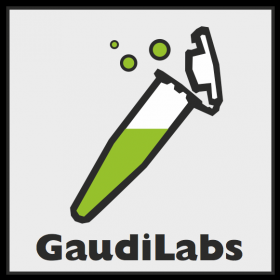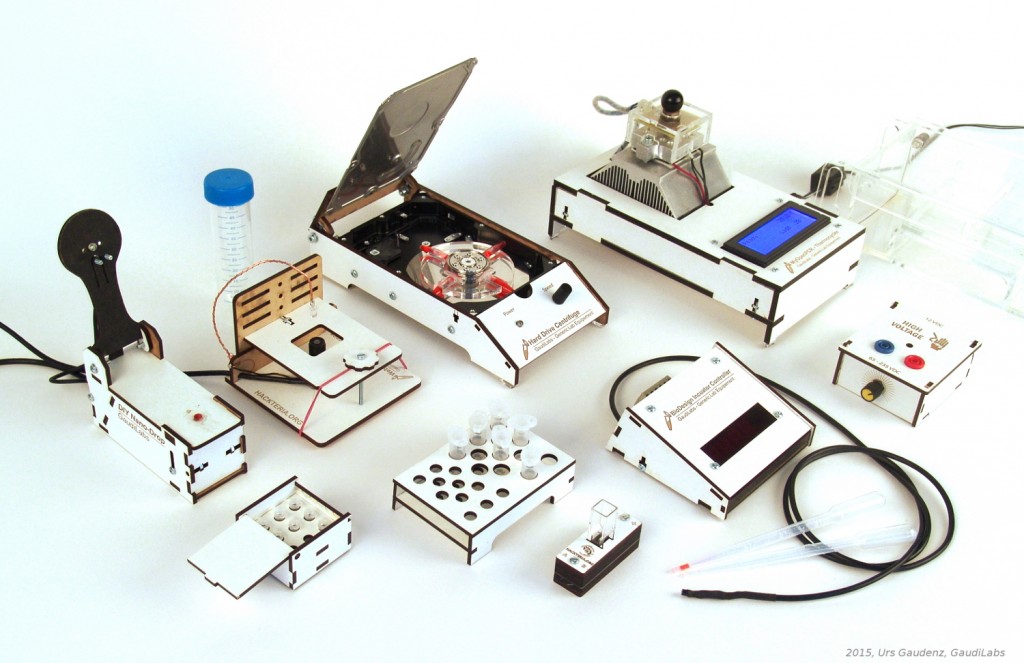
To start up an independent and open lab it is crucial to get affordable lab equipment. Most of the tools we use are do it your self (DIY) and open source and are built from widely available and recycled parts found in consumer products such as DVD drives, hard disks and pc fans. Building the specific devices further helps to understand the basic principles behind and learn more about the technologies and methods used. The discussions among scientists and engineers in the process of rethinking the devices to make them more accessible are very fruitful and often lead to new and innovative designs.
Support the pursuit and growth of knowledge through open science hardware (GOSH): http://openhardware.science/gosh-manifesto/
See also summary of Hackteria Open Source Hardware
WebCam Microscope
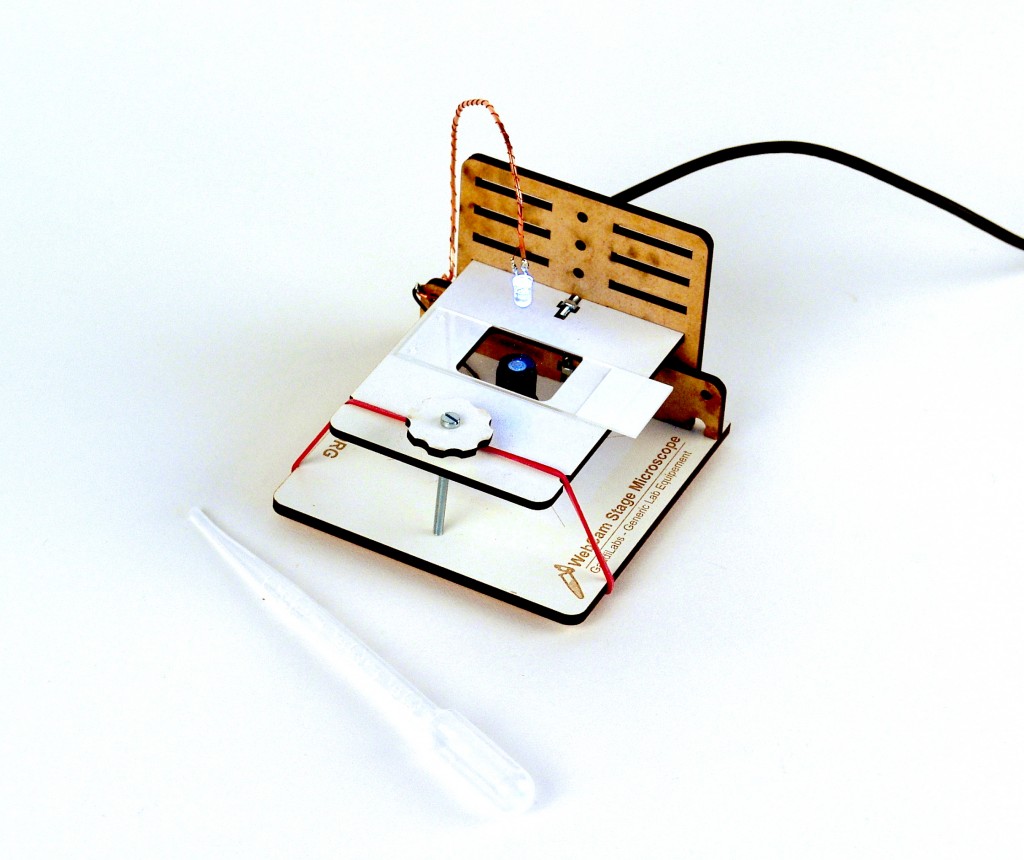
To use a regular usb computer web-cam as a microscope, only a few modifications are needed. Basically flipping the lens upside down does the trick. No extra optics needed. Microscopes open up the world of the small and allow the magnified observation of small life forms, analysis of biological motion and form, as well as audio-visual interpretations for aesthetic presentation. The link to the computer allows easy viewing, taking pictures and and even capturing movies.
Do It Your Self
The current design of the typical hackteria webcam microscope stage grew out of literally hundreds of Do-It-You-Self workshops around the world. While making your very own set-up from cardboard, lego or wood is still the most fun and educative approach, this laser cut kit provides a fast and flexible way to get a stable and very accurate microscope. Unlike many of the commercial microscopes this design is a so called inverted microscope with camera looking up and the sample holder on top. This gives you good access to the sample and makes inspection very intuitive. The base plate with rubber feeds provides a solid stand. The sample table can be adjusted to a big range of webcams. The little wheel with a screw is used for focusing. A white LED or any table top lamp is the light source.Link1 Link2
Hard Drive Centrifuge
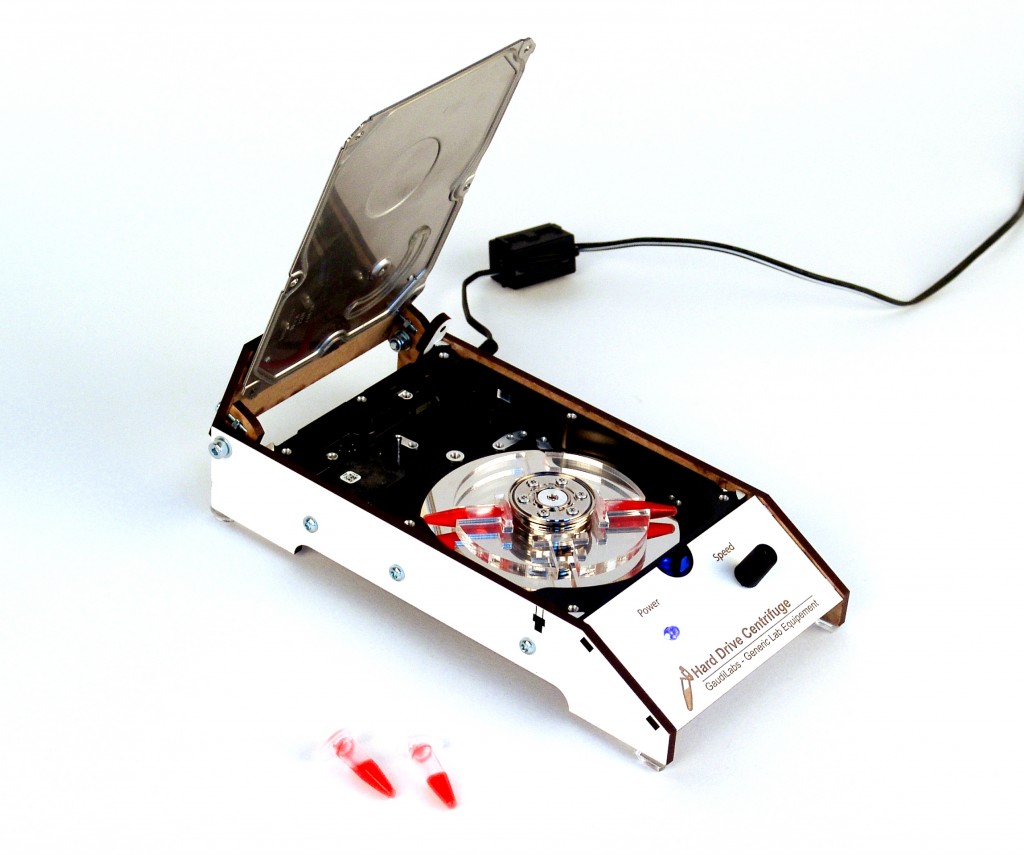
A centrifuge is a rotating wheel with very high rotational speed (RPM) and a strong body protecting the people around from the energy of the fast moving parts. Substances are loaded into the vial holders at the edge of the fast spinning wheel and are separate along their different densities. Fast spinning computer hard drives in a solid aluminium housing are perfect for making small DIY centrifuges.
How To
The design is based on conventional 3.5″ desktop hard drive. You usually need a small torx screw driver to open them. The disks are removed and replaced by a laser cut acrylic tube holder. Only small centrifuge tubes (0.5 ml) can be used with this kind of design. Make sure the tube holder fits well on the shaft of the motor and fix it back with the original down holder. The parts for the housing provides a stable stand and allow easy opening of the lid. To drive the motor replace the electronics by a ESC brushless motor driver for RC cars. To control the speed use a so call “Servo Tester” unit that fits well with the motor driver. Link
Download design file
Download wiring schematic
Incubator Controller
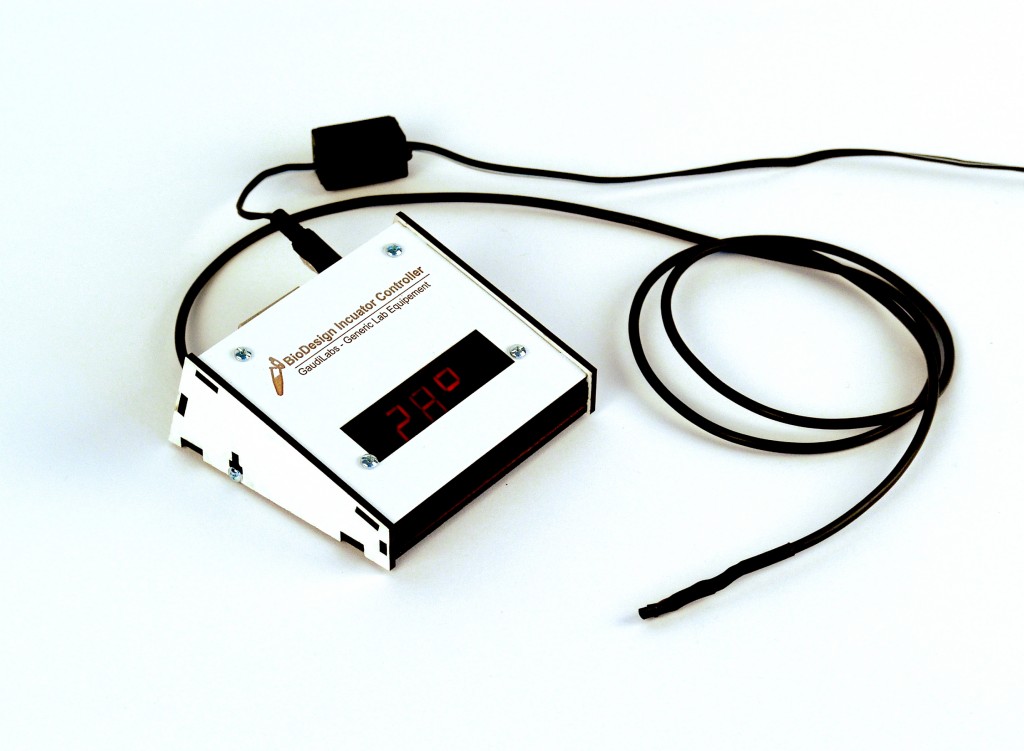
An incubator is an isolated storage place that is used for cultivating bacteria. The incubator maintains optimal temperature of the atmosphere inside it. Incubators are essential for a lot of experimental work in cell biology, microbiology and molecular biology. More advanced devices also control the humidity in the chamber.
Where to get it
There are many designs for simple electronic temperature controllers. Some are sold for breeding chicken eggs, some a open designs based on an arudino micro controller. Even just hacking a IKEA thermometer does the trick. The one shown here was designed as part of the project biodesign for the real world. As a heating element use a light bulb or a big electric resistor. The temperature isolated chamber can be made from a styrofoam box or from an old camping fridge.
Documentation of project on hackteria.org
Gel Box and High Voltage Supply
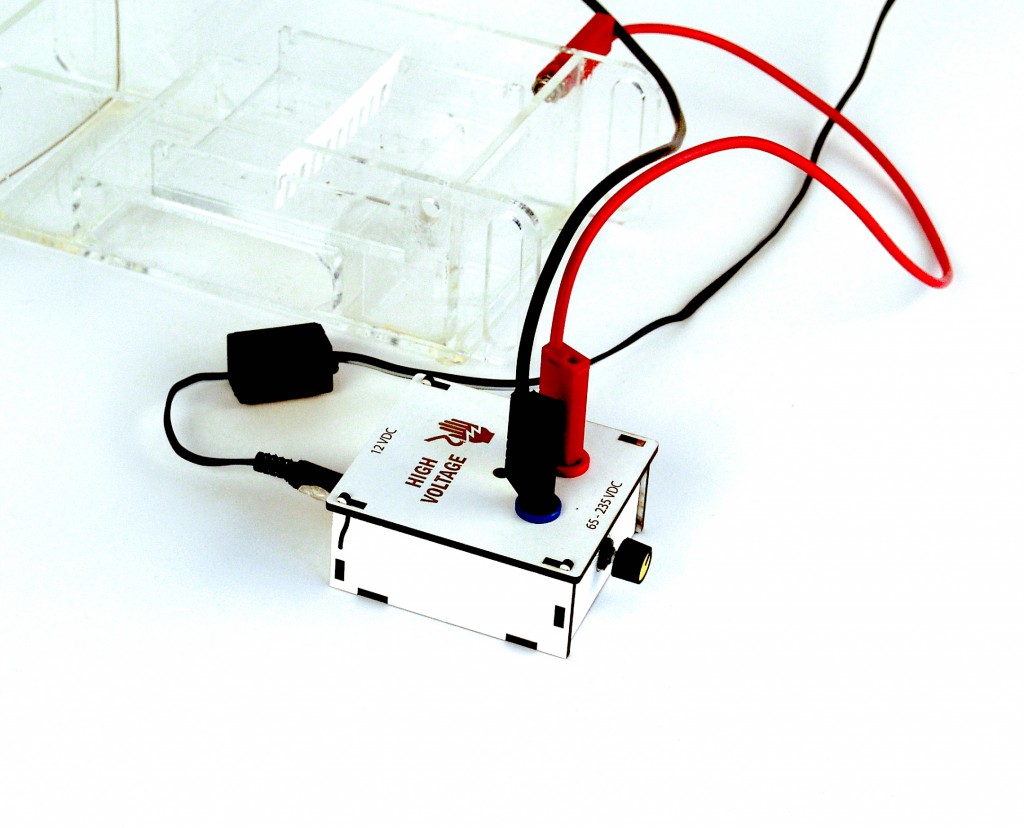
The gel electrophoresis box is a basic tool used in bio labs to separate molecules of different sizes. By comparing with a reference DNA sequences of specific length can be identified. Various excellent do it your self instructions are available on the net. And agar is the new media.
A simple and effective design of a circuit that converts low voltages (12DC) to higher voltages suitable to drive a electrophoresis box or an electro wetting device is published unter the name of “Nixie HV Switching PSU” by Nick de Smith. See the following links:
Detailed Instructables on how to build it.
Turbidity Meeter Kit
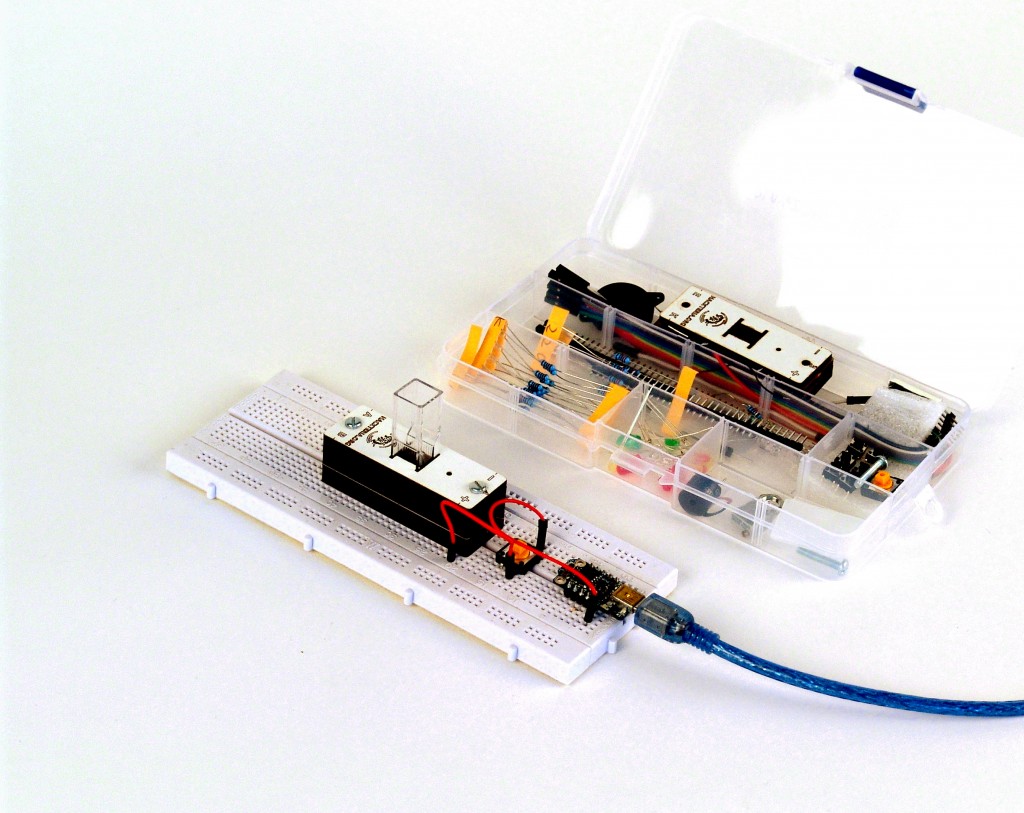
Co-Development of a workshop on DIY laboratory instruments for bioanalytics. Turbidity meeter built from simple DIY electronics combined with an enzymatic assays. With a concept of “teach the teachers”, we are looking into DIY lab-tools as means of a pedagogic tool for interdisciplinary thinking at the biomedical/engineering/molecular interface. Coproduced with SATW, Swiss Academy of Technical Sciences, Hackteria and FHNW, School for Lifesciences.
Documentation of Project on hackteria.org
See also TurbiGnUSB an integrated version with microcrontroller.
DIY Microvolume Spectrometer
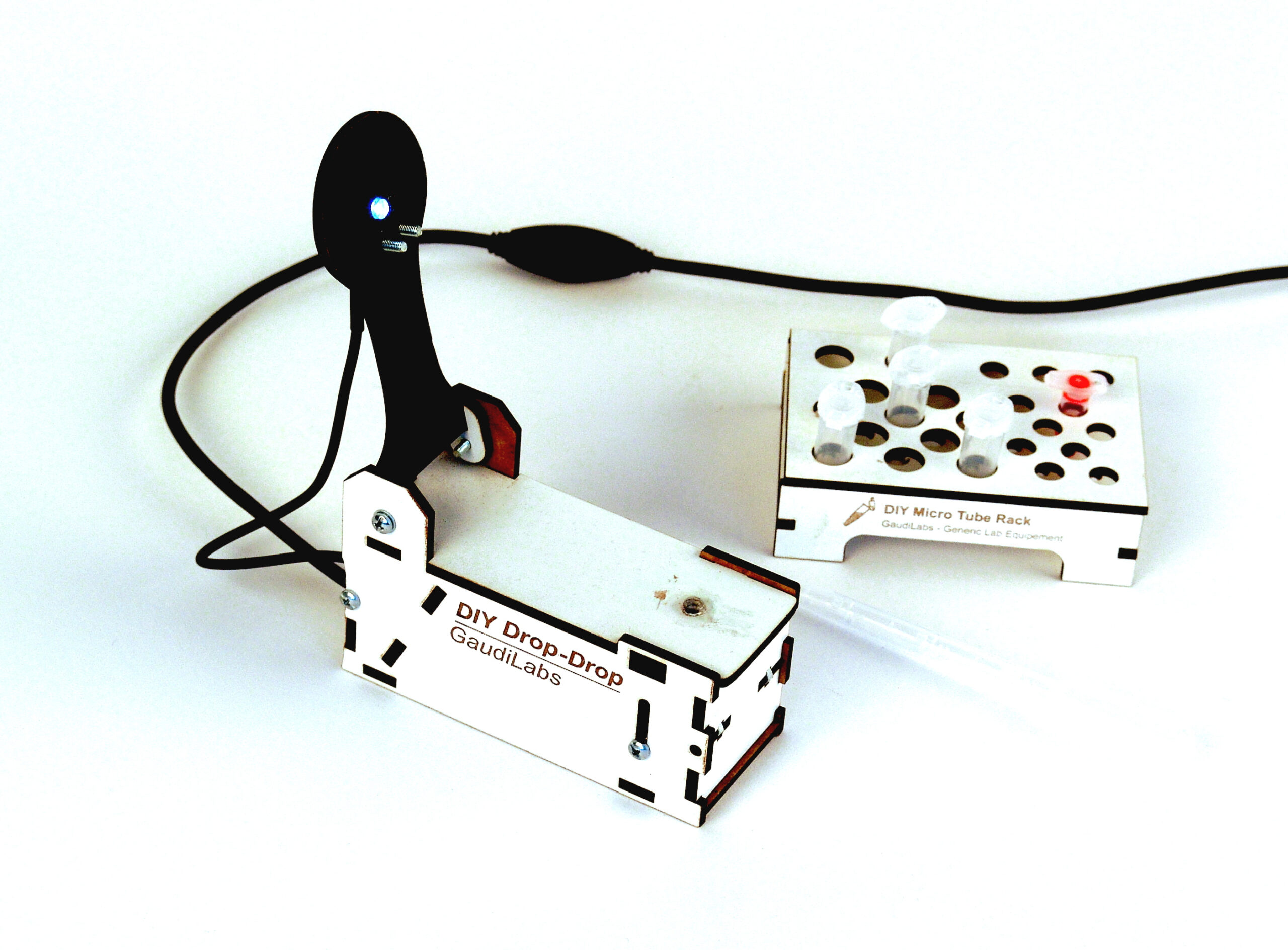
Microvolume spectrometers are popular products in scientific labs. The measurement principle of holding a drop between two points – the light source and the sensor – allows to measure samples as small as 0.5µL up to 2µL micro volume without a cuvette. The simple basic principle should be perfect for DIY lab equipment. Possible applications are Turbidity measurement, measure spectral data and purity, potentialy measure nucleic acid, protein and colorimetric assays, microvolume fluorescence measurements.
This version of a DIY microvolume spectrophotometersfor is based on a DIY spectrometer using a DVD-R optical diffraction grating and a USB webcam as described by PublicLab. The light source is a white 5mm flat head LED. The device is sensitive in the visible light spectrum. The standard webcam can be connected to a computer by USB to get the image of the spectrum instantly. Use the PublicLabs excellent online software workbench to analyse data.
Documentation of the project on hackteria.org
My Open PCR
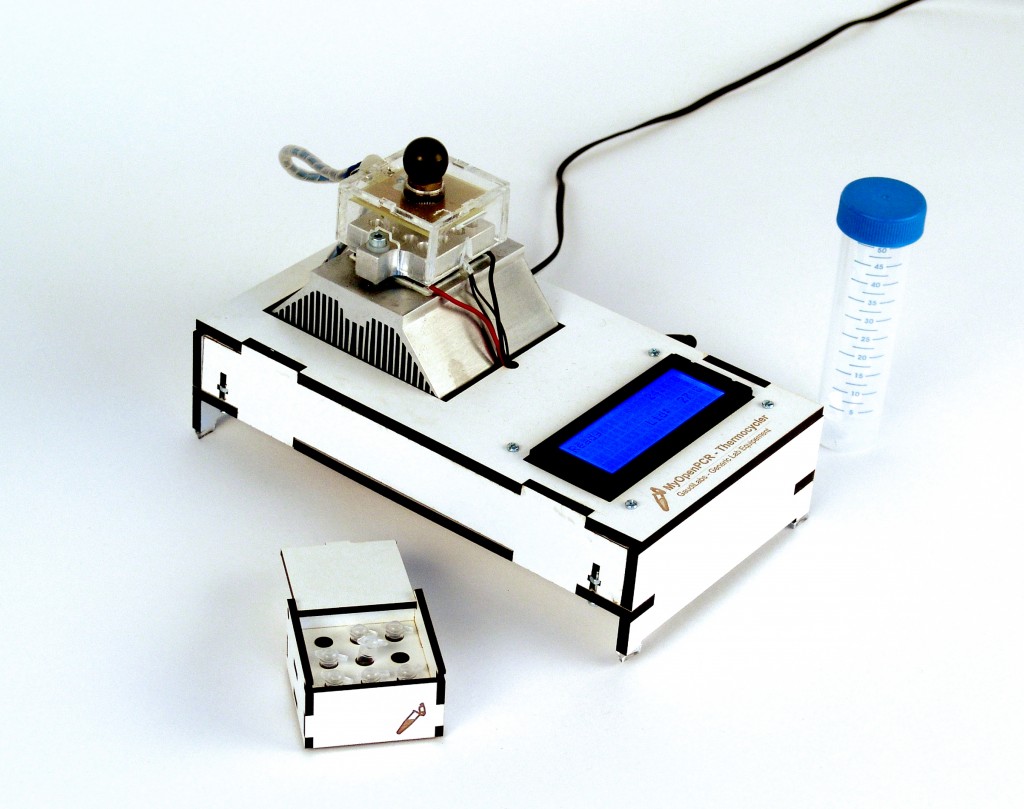
Attempt to build an OpenPCR just from the description on the website OpenPCR without a kit or any supplied parts.
call it free/libre open source There is two aspects to open source hard and software. The one is to build an new product in a community, include different people and skills, combine ideas in the process. To do so developers share files and knowledge openly. And once the product is completed, “consumers” can buy the product like any other product without knowing much about it. Maybe they build it from a kit to get it cheaper and learn a bit about how the product looks inside.
The other openness, some call it free/libre open source, does not distinguish so much between developers and consumers. Everyone should be able to have access to the design, source the parts, build the device, modify it, make derived works, redistribute and use it commercially. To be that open, more information than just source files is needed… with the present rebuild of the OpenPCR I try contribute some to this…
https://github.com/GenericLab/WildOpenPCR
Documentation on hackteria.org
Tube Racks
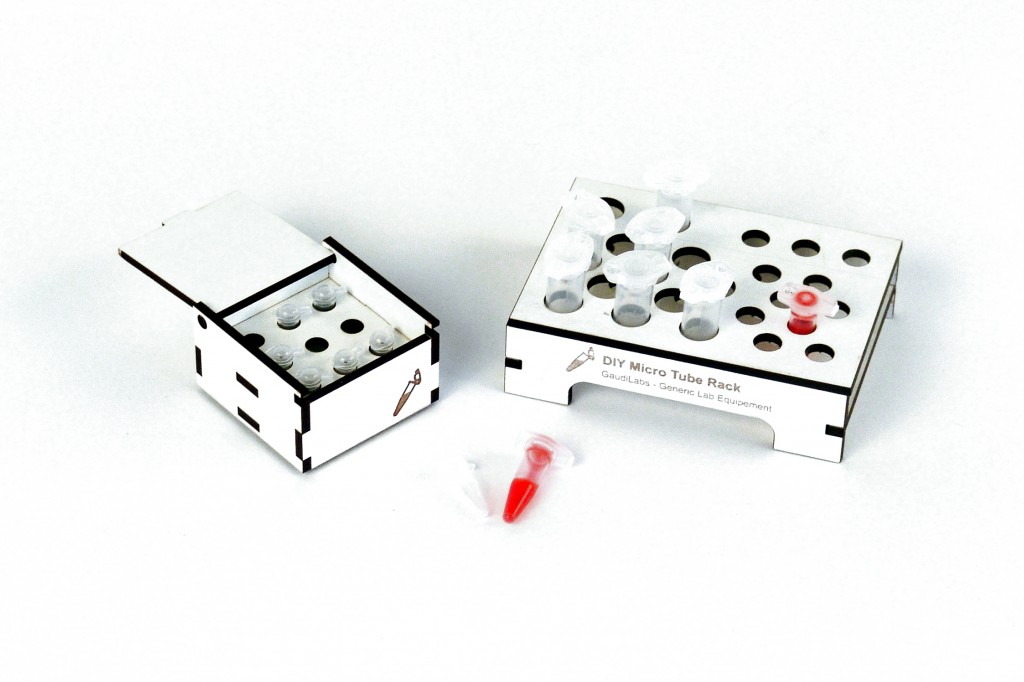
Not only sophisticated devices are required in technology labs. Simple equipment like this tube holder are also very helpful and often unnecessarily add to the initial investment cost when bought from conventional vendors. Many of these helpers can be manufactured on a laser cutter in FabLab in no time.
– GaudiLabs in a Suitcase
BLUE Transiluminator
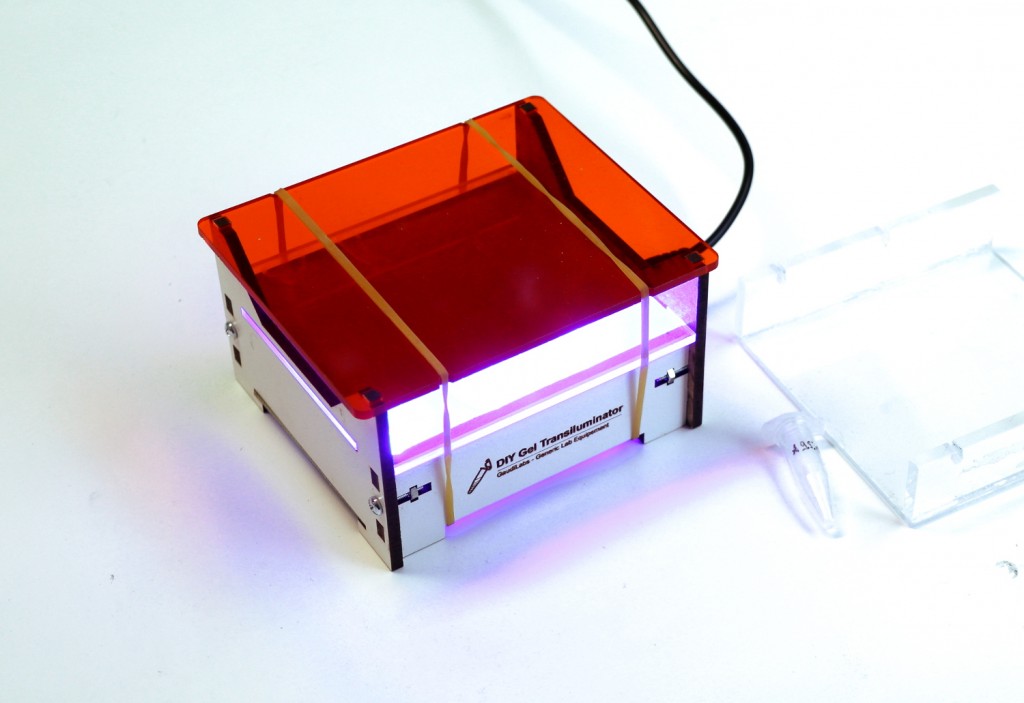
Transilluminators are especially useful to see DNA bands on a gel.
UV Transiluminator
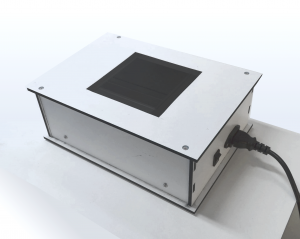
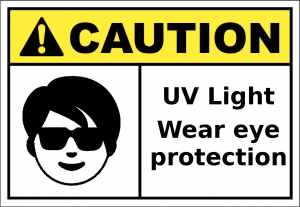 Sticker
Sticker
DIY Electrospinner
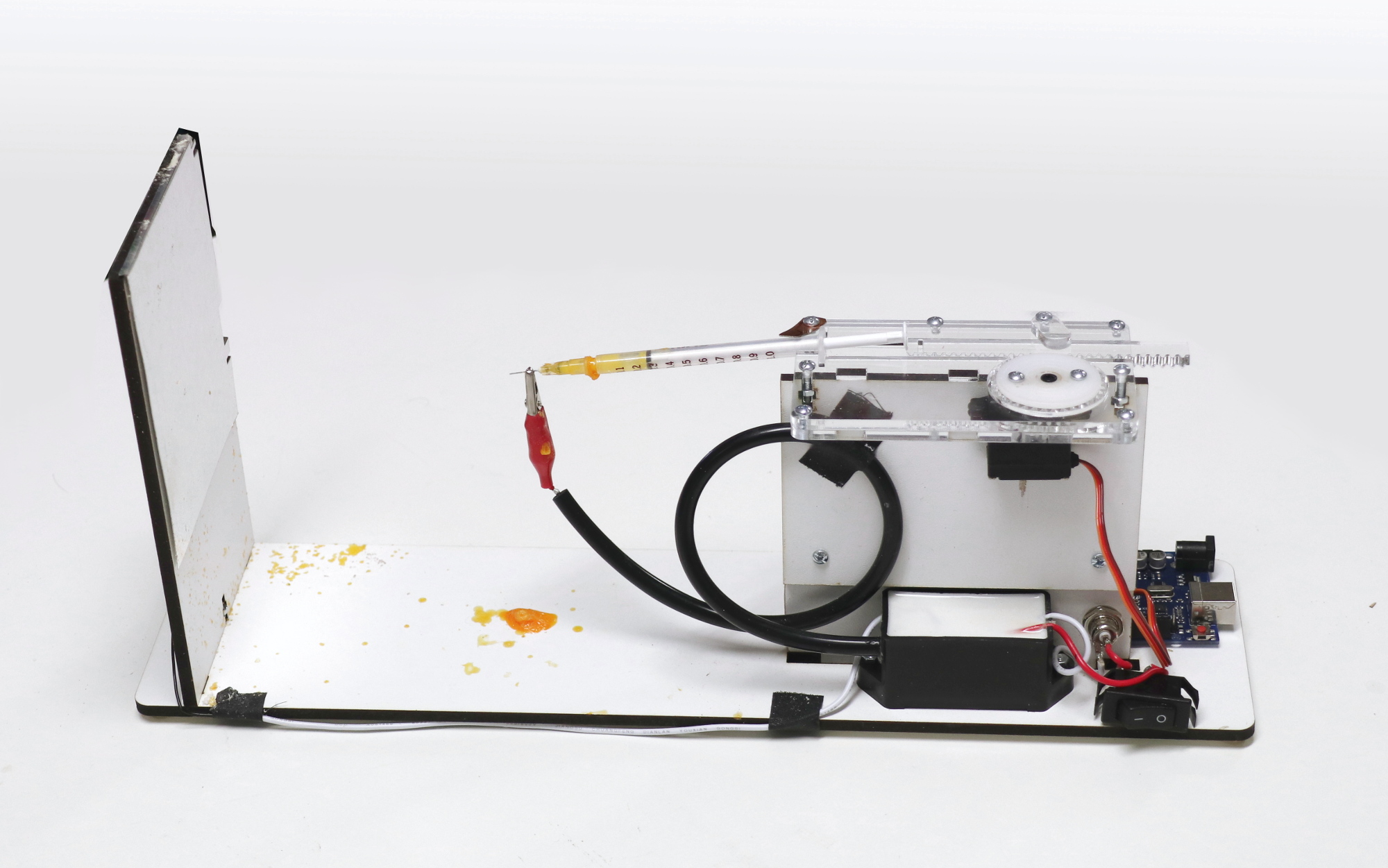
Electrospinning is a method to produce very thin fibers from polymer solutions through an electric field. In this case, the polymer solution is pushed through a syringe needle by a servo motor and accelerated at the electric field. The high electric voltage of about 10 kV is produced by an “Pulse Generator Inverter” from ebay. In a complex process, the polymer solution is spun into very small fibers which ultimately deposit on the counter electrode as a kind of fleece similar to a dens spider net. The process typically produces fibers with diameters of less than 1000 nm, which is why the products are called nanofibers.
Polymer solution used: ABS dissolved with acetone.
DIY Spin Coater
A spin coater is a machine used to apply uniform thin films to flat substrates. An excess amount of a solution is placed on the substrate, which is then rotated at high speed in order to spread the fluid by centrifugal force. This simple spinner is made from pc blower with the blades cut off and put into a acrylic housing to prevent the excess solution to coat all the lab.
Link
DIY Spin Coater Pro (with vacuum chuck)
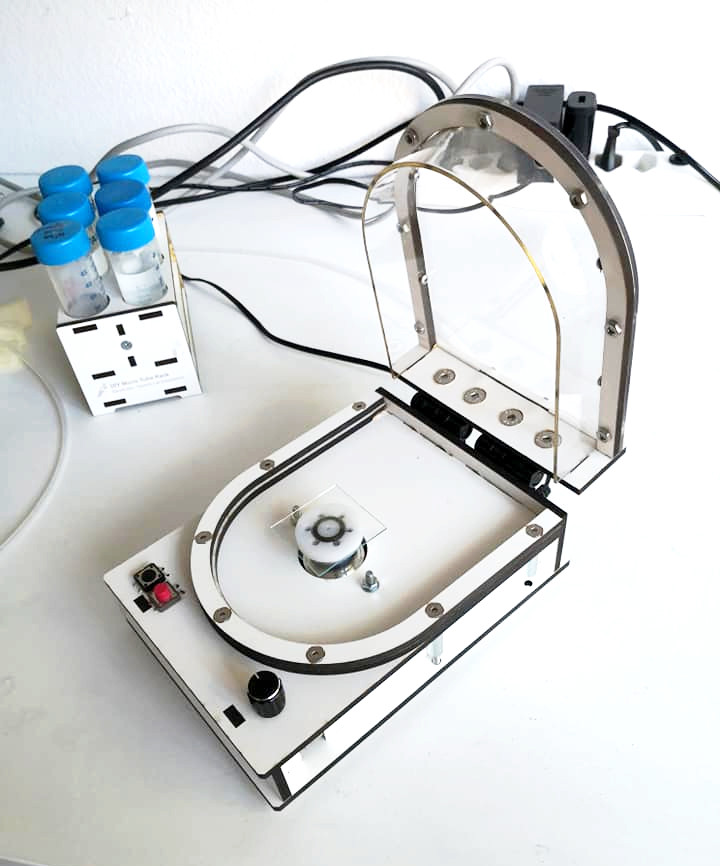
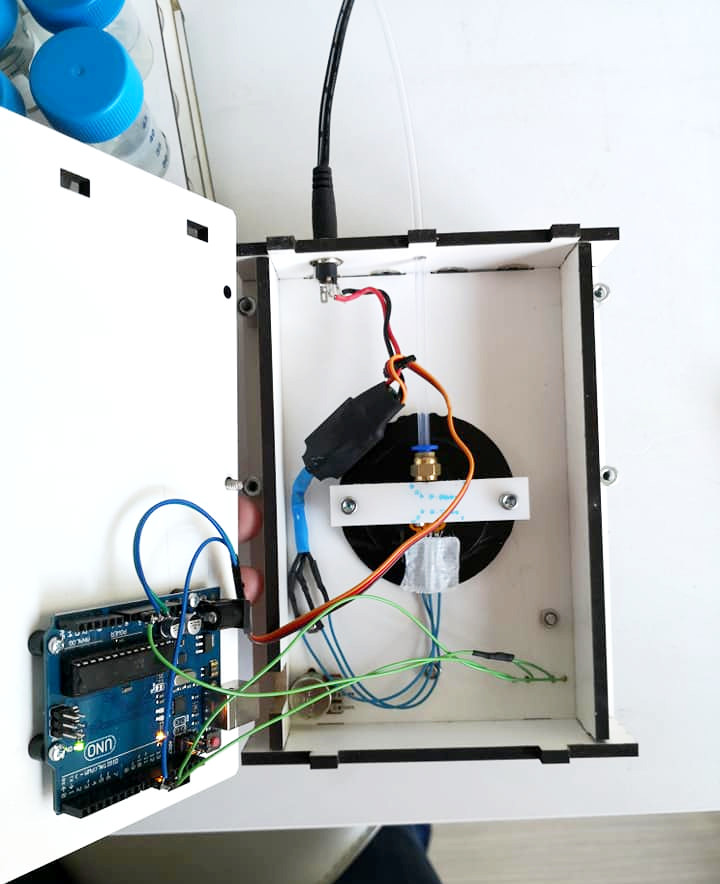
BioBox
The GaudiLabs BioBox is a prototype of a universal measurement and control device for use in bio laboratories. The device can read temperature sensors, control motors or pumps, measure frequencies, or analogue voltage and can even be connected to a electronic scale. The device is based on the arduino electronic platform, features a display, a knob and 8 electric ports and can be reprogrammed to many more functionalities. Link
MORE
Some open source files:
DIY Incubator – http://www.gaudi.ch/GaudiLabs/wp-content/uploads/DIYIncubator.zip
DIY Shaker – http://www.gaudi.ch/GaudiLabs/wp-content/uploads/DIYShaker.zip
DIY SlideALyzer – http://www.gaudi.ch/GaudiLabs/wp-content/uploads/DIYSlideAlyzer.zip
Mivo – Micro Volume Absorption Meeter – http://www.gaudi.ch/GaudiLabs/wp-content/uploads/Mivo_MicroVolumeAbsorptionMeeter.zip
Laser Cut Tube Rack – http://www.gaudi.ch/GaudiLabs/wp-content/uploads/TubeRack8.zip

